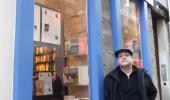Tuesday, July 30, 2024 - 6:30am
'Magic Trip' takes psychedelic ride with Pranksters
John F. Kennedy and Ken Kesey were both looking forward to the 1964 World's Fair in New York. Everybody in America was. World's fairs mattered in those days, and New York hadn't hosted one since 1939. A charming clip in the documentary at hand shows JFK gingerly pressing the squares on a new-fangled push-button telephone as he says, "By dialing 1-9-6-4" -- not touching -- "I launch the final phase of this great effort."
He wouldn't live to see the fair or the year. His death was the death of American innocence, from which, half a century later, we still haven't fully recovered. But one disillusioned bunch of West Coast young people decided to go to the fair anyway.
They would soon be illusioned.
At 29, Ken Kesey, "one of America's greatest writers," led a scruffy band on "a bus trip across America that changed everything," declares narrator Stanley Tucci. Their search for themselves and America was largely conducted on LSD.
Directors Alex Gibney and Alison Ellwood can be forgiven some hyperbole in what is basically a terrific doc. Mr. Kesey (1935-2001) was the author of two highly influential books, "One Flew Over the Cuckoo's Nest" and "Sometimes a Great Notion." Whether he was one of our "greatest" writers and whether his cross-country odyssey "changed everything" can be debated.
But there's no question that the Magic Trip became a major countercultural milestone. Inspired by Jack Kerouac's "On the Road" and John Steinbeck's "Travels With Charley," Mr. Kesey set out from California with Beat Generation bad boy Neal Cassady (aka "Sir Speed Limit") at the wheel of an ancient yellow school bus, repainted psychedelically for the occasion.
It wasn't so much a bus as a philosophical concept, Mr. Kesey says. Its passengers were pleasure-seekers of a generation-on-the-cusp: "We weren't old enough to be beatniks, and we were a little too old to be hippies." But he had one clear purpose: to make a spontaneous road movie (gas = 28 cents a gallon) with a 16mm camera and a reel-to-reel tape recorder. Unseen until now, it's a reality show ahead of its time.
Mr. Cassady was not just ahead but the head of his time -- a pre-Hunter Thompson Dr. Gonzo and real-life model for Mr. Kerouac's Dean Moriarty in "On the Road." Other zany, amazingly good-natured and confrontation-free "Merry Pranksters" on the trip included people with names like Gretchen Fetchen, Stark Naked, Mal Function and Generally Famished (Jane Burton). Supportive wife Faye and son Zane comment later.
In one riveting segment, Mr. Kesey reveals his first LSD experience in a hospital where experiments were conducted by the CIA, which thought the drug had possibilities for interrogational use. Human guinea pigs were paid $25 a day, and the taxpayers got their money's worth with Mr. Kesey's articulate descriptions of "concentric math patterns, hexagons, discordant colors" -- beautiful one minute, terrifying the next.
Nobody knew what dosage of LSD cocktails they were taking, on or off the bus. Marvelous footage shows gorgeous Stark Naked's joy and terror during a dip in a pond, where she feels "the algae welcoming me into its existence!'"
Stark never quite recovered, we are told: "All her molecules never came back together."
Mr. Gibney is the Oscar-winning director of "Taxi to the Dark Side" (2007), an expose of American torture in Afghanistan and Iraq, and of the superb "Enron: The Smartest Guys in the Room" (2006). He and Ms. Ellwood have digitally improved and adroitly edited the "Magic Trip" material, painstakingly synchronizing sound to images. (They had to hire a lip reader to help determine what words people were speaking in what shots.) The result is a pristine time capsule of 1964 America in full color (most footage of that era being black and white). It makes you want to re-read Tom Wolfe's "Electric Kool-Aid Acid Test" and re-listen to the Grateful Dead, the Pranksters' unofficial back-up band, whose "Truckin' " became their great anthem.
Cameos by Allen Ginsberg and Timothy Leary frame the big generational question: "Can you pass the acid test?" Most people's LSD revelations are, in fact, more loopy or tiresome than profound -- and the freak-outs aren't pretty. True confession here: My own first psychedelic experience as a strait-laced 19-year-old was quite involuntary, when a "friend" dropped a tab of acid into the Pepsi I was drinking without telling me.
Not all such pranksters were nice. "No matter how hard I try, I will eventually lie to you," was one of their mottos, and they tended to abandon anyone like Stark who couldn't keep it together. But Mr. Kesey himself is genuinely lovable, gently guiding his chaotic Lewis & Clark expedition. His subsequent repudiation of LSD was inevitable (like most people's).
"We went wild for a while," he says, "because we were caged up for 50,000 years, but now it's getting away from us ... time to stop."
At the time, though, there was a certain internal logic to the drug-drenched self-indulgence, and seeds of the embryonic feminist and civil-rights movements. ("God, there's a lotta colored people here!" one of the Pranksters says, as they integrate a segregated beach in New Orleans without knowing it.)
Mind-and-reality-altering was the whole point. 'Twas ever thus, down through the history of all substance use and abuse, from ancient Greek bacchanalias to Joe's Bar (all 43 of them) on East Carson Street.
How appropriate at the end of the trail, finally reaching the New York World's Fair, to find its definitive DuPont exhibit: "Better Living Through Chemistry."
* * *
[Ed. Note: ¡Gracias a Tia Catalina Henkel para una corrección importante!]
Vote:






